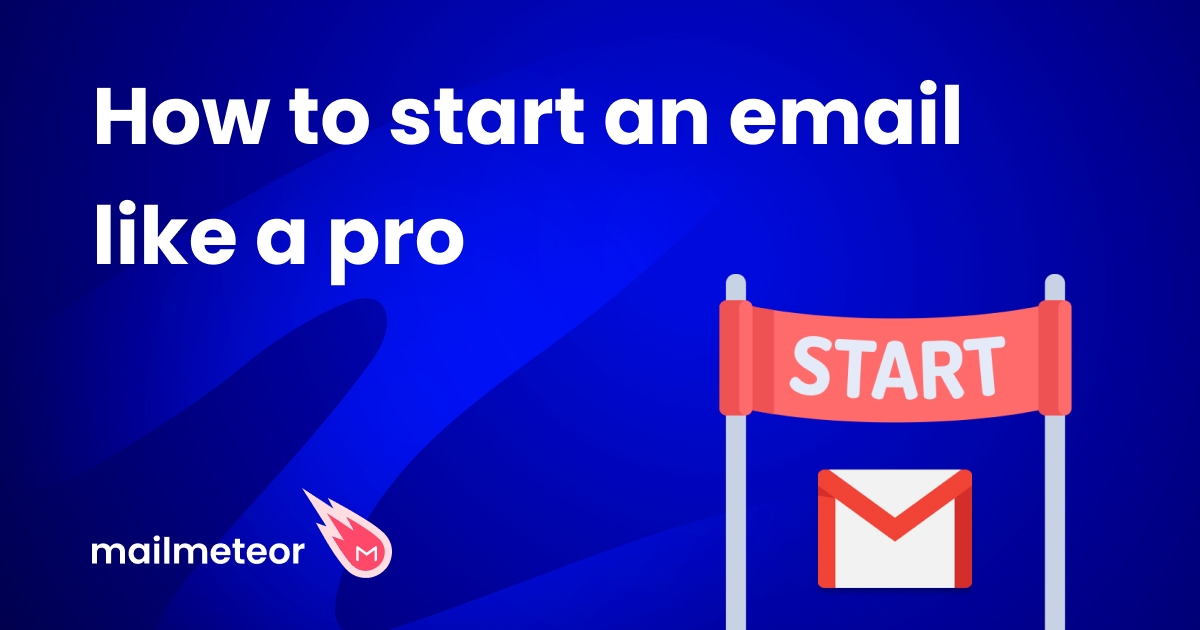You don’t need to be a SEO expert to drive more traffic on your website. In fact, all you need is a few hours in front of you and $7.
I used to find SEO to be a daunting task. To make things easier for everyone (me included), I gathered over the years a complete list of actionable tips that anyone can apply to improve SEO.
Today I’m sharing these as 25 recipes. For that, I will be using a tool called Ahrefs, one of the most popular SEO tools out there (even though the principles shared here could be used with other software).
I choose this tool more than any other because it’s both very complete and easy-to-use. You can explore all of its features and lay out your complete SEO strategy for just 7 dollars. Just to be clear, I’m not affiliated to Ahrefs ;)
The SEO recipes are divided in 5 main themes:
PS: If you stay until the end, I’ll show you a special email outreach recipe for SEO using Mailmeteor, our tool to help you send personalized mass emails with Gmail.
Let’s wake up the SEO chef that sleeps in you!
Keyword research
Tip #1 - Find low competition keywords
This recipe will help you find keywords that are easier to rank for because the competition is lower. Adjust the volume filter to your needs to narrow down the list. Play with the CPC filter to find keywords with a high commercial value (CPC => $5).
The idea here is that if people are paying good money to advertise for such keywords, you can bet that they have commercial intent. Additionally, target keywords with commercial intent such as “price, “buy,” “hire.
Try focusing on the traffic potential of a topic rather than a single keyword.
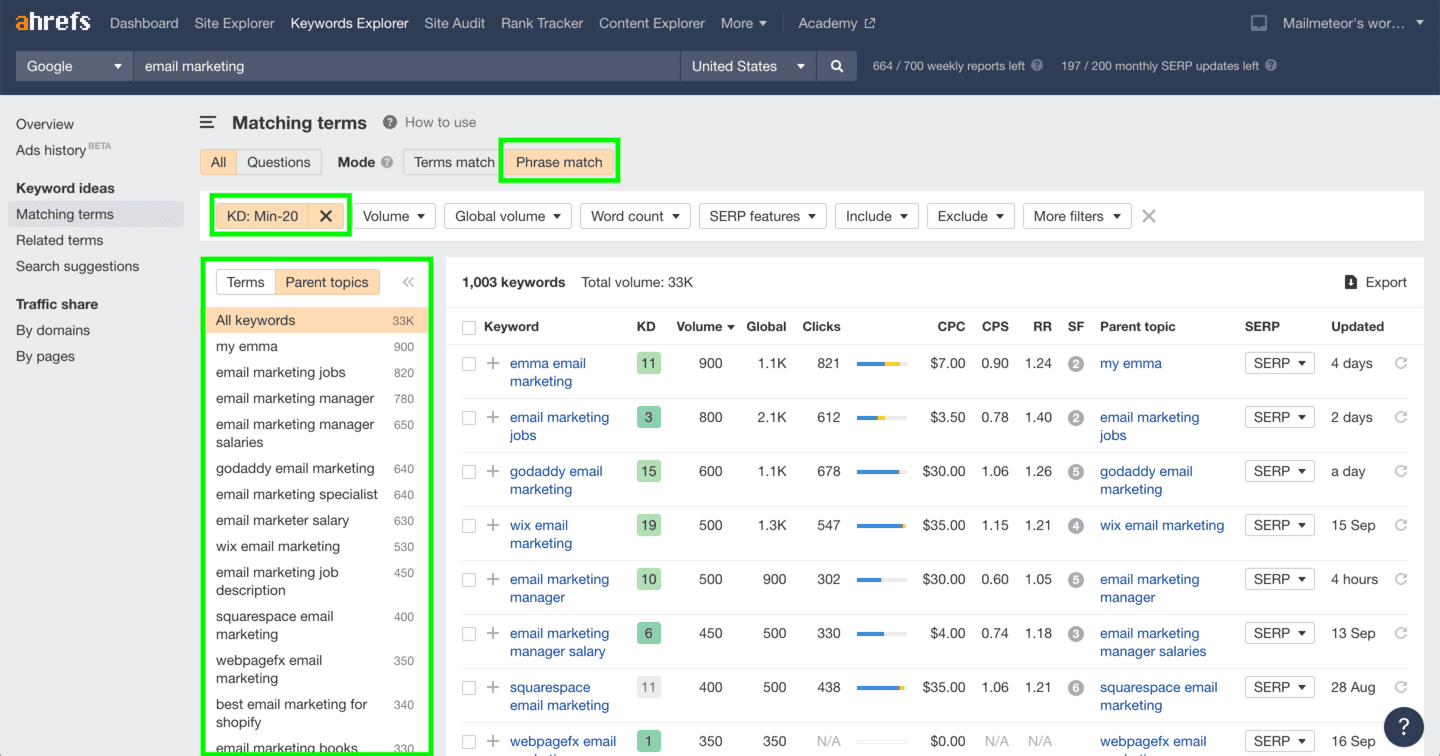
Tip #2 - Identify your underperforming keywords
Your site ranks for keywords organically but not all of them rank in the top spots.
To identify which keywords you need to focus your efforts on, we are going to isolate the keywords your site ranks for in the top 10 first results.
We’ll filter out keywords with lower volume, usually 1000 is a good proxy for the average monthly number of searches, but in our case I have set the threshold lower to capture more keywords. In addition, we can make sure to exclude all owned SERP features as we only want to see “true” rankings (SERP features are any result on Google that is not a traditional organic result, they include featured snippets, ads, videos…).
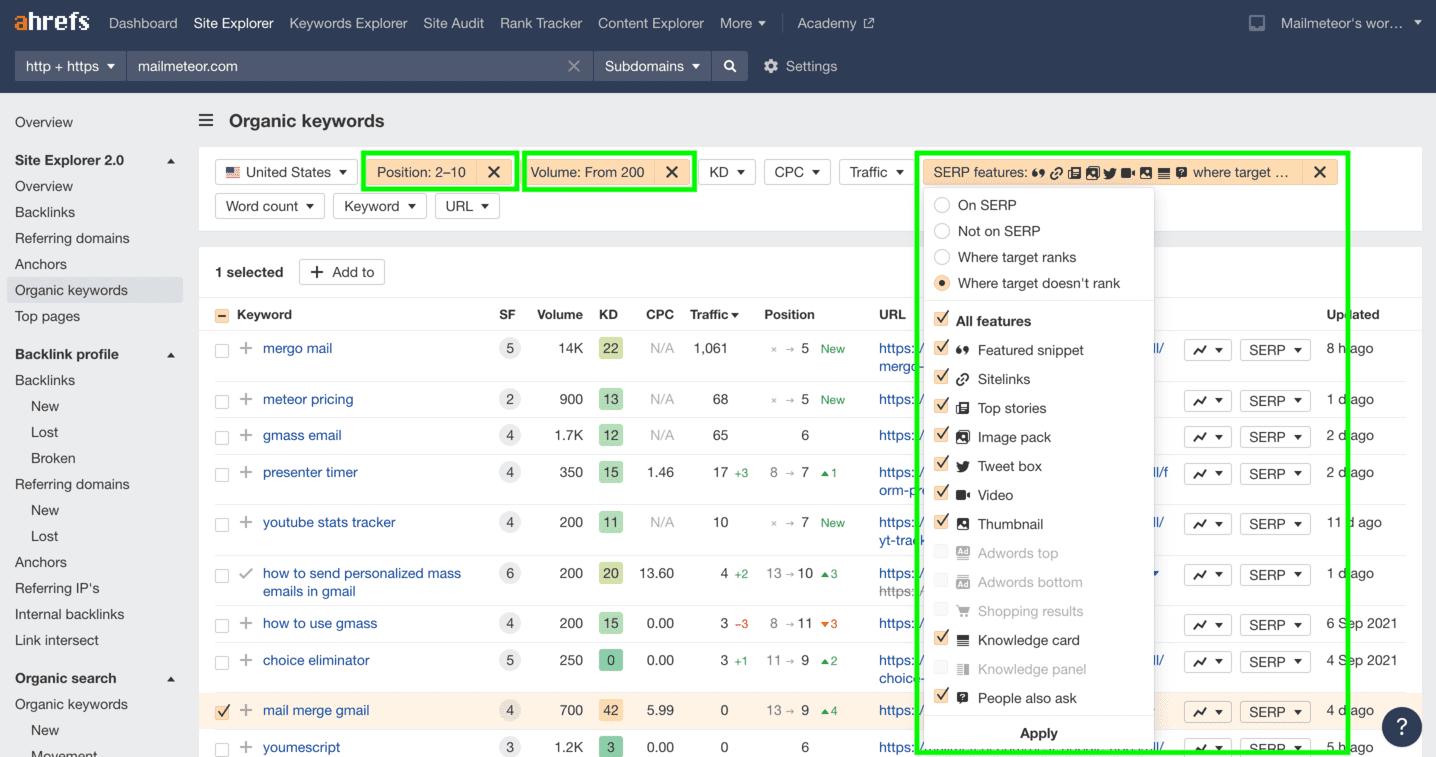
Prioritize your efforts by picking the following keywords:
- The ones that already drive the most traffic
- The ones with high search volumes
- The ones with low KD score
- The ones with high business values
- That are not branded keywords (eg google.com), because it will be difficult to compete
- Without SERP features
After identifying the keywords your want to focus on, here are some advices to push your page in the top spot:
- Add some more internal links to the pages
- Build some fresh backlinks to the pages
- Update and relaunch your content
- Make sure on-page is optimized for the exact keyword
Tip #3 - Know whether to target two similar keywords on one page or separate pages
Sometimes you may have keywords with similar meaning and you’re unsure whether you need to put them in the same page or separate pages. This keyword mapping recipe will show how much their SERPs overlap.
In our example, all the top 10 pages target both keywords variation on the same page. It’s a good idea to follow the same path. This is pretty useful to prevent keyword cannibalization, that is when several of your pages compete for the same keywords.
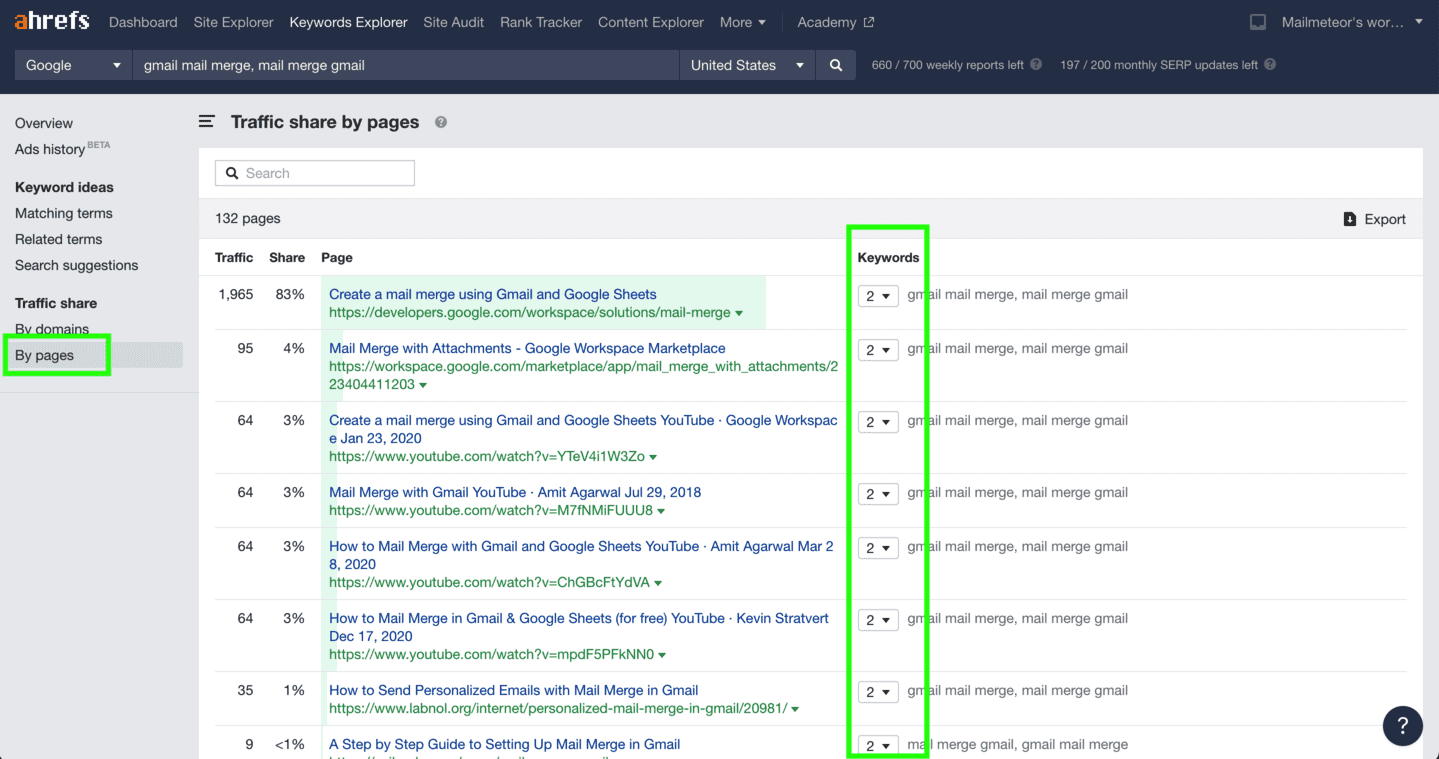
Tip #4 - Find uncompetitive topics that forums rank for
Most of the time, when user-generated content - like forum posts - ranks in the first position, it’s a sign of an uncompetitive topic.
Indeed, this kind of content is less well written than a proper blog post. Browse the top results for your target keywords and try to spot forums. Then using the formula above, look at the top pages for this forum to find uncompetitive topics opportunities.
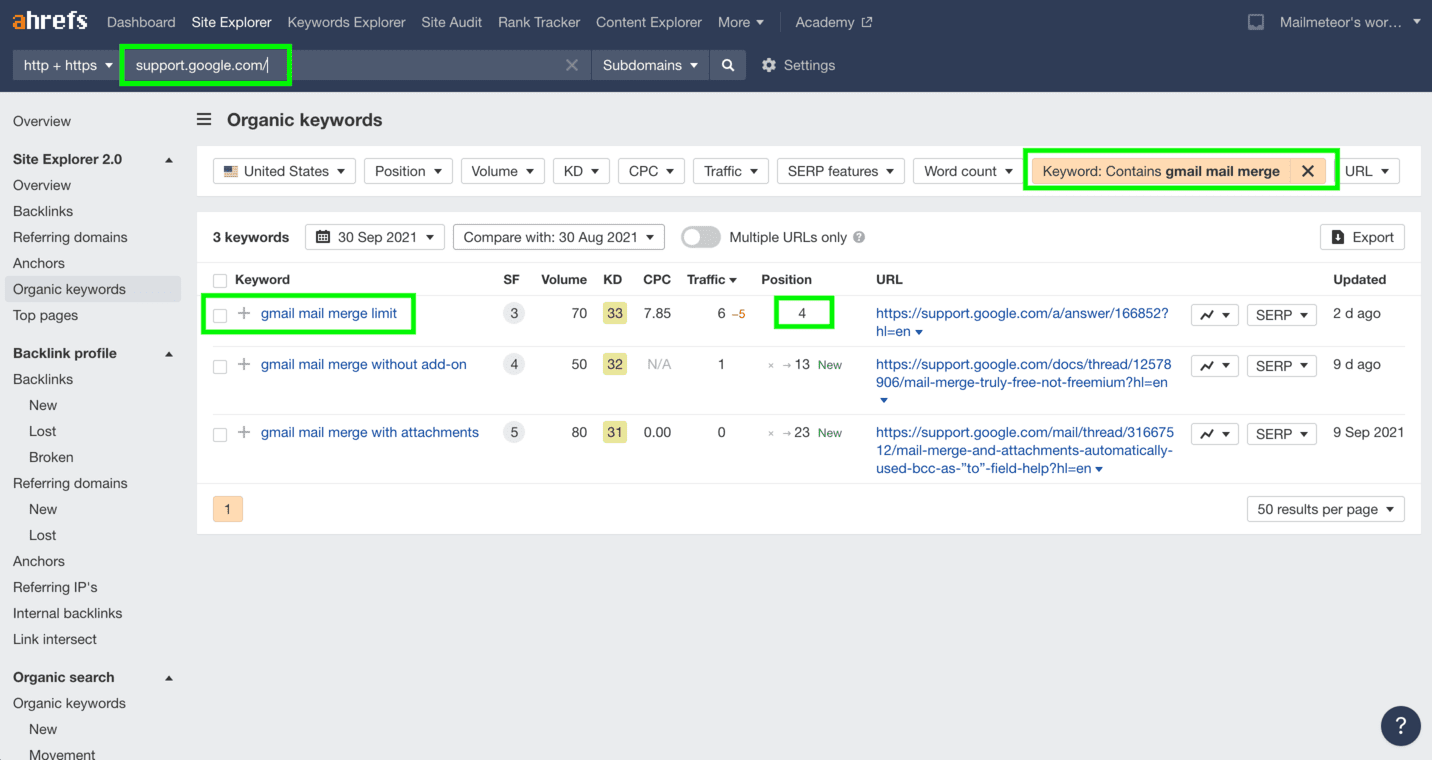
Audit your content
Tip #5 - Optimize for ‘definition’ featured snippets
Quickwin: find keywords where your site ranks in positions 2-10, while the search results have a featured snippet. You may be able to own the featured snippet and rank #1 by making a few edits to your article. It can be interesting to filter results by adding the “what” or “how” keywords in the Include filter.
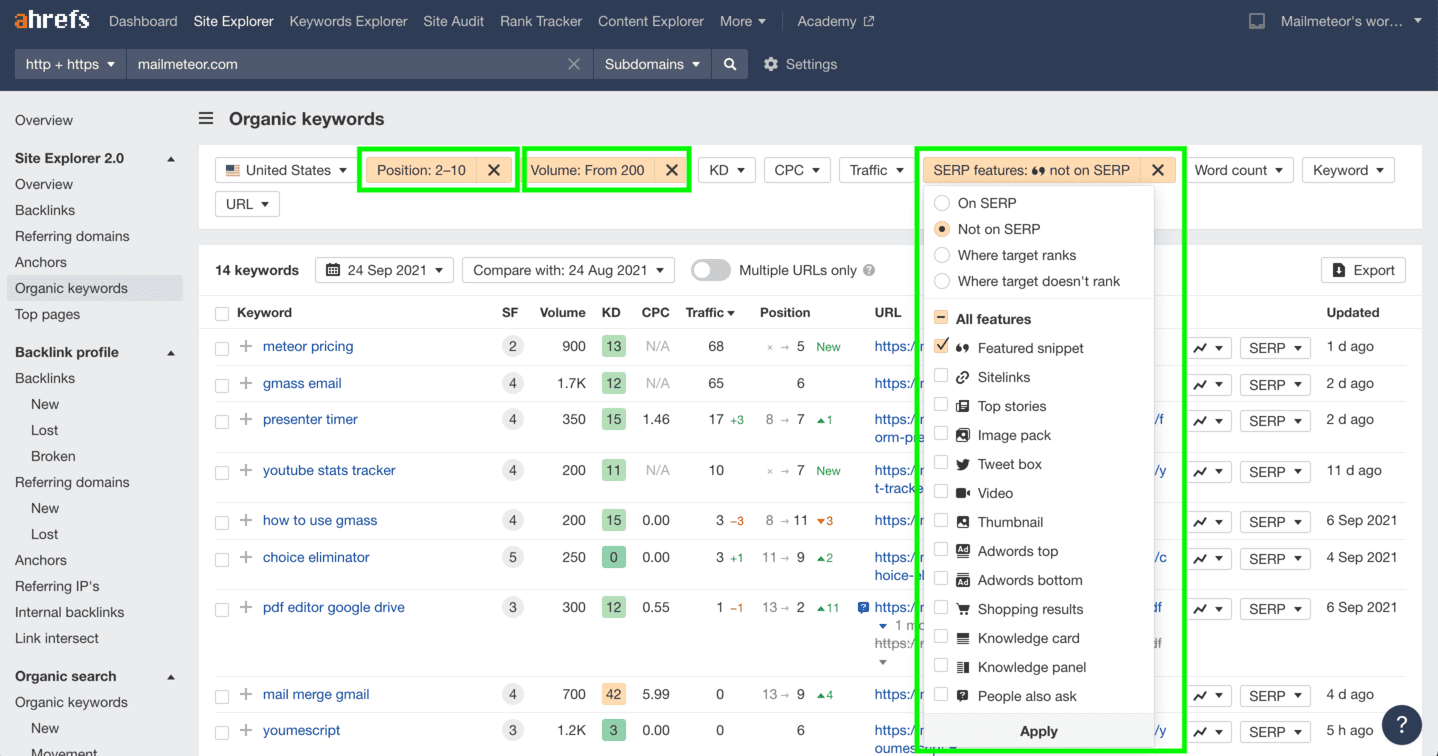
Tip #6 - Boost important posts with internal links
Internal linking is when you link pages from your website together. It plays a strong role in SEO because it helps passing “SEO juice” from your high-authority pages to the ones that need a boost. Knowing that, you’ll need a simple method to identify these pages.
First, let’s find pages that need a boost. Look at the pages ranking in position 2 to 10 using the recipe above. It will give you a list of pages that would benefit from internal linking. Here I selected our Gmail newsletter landing page that we’d like to boost.
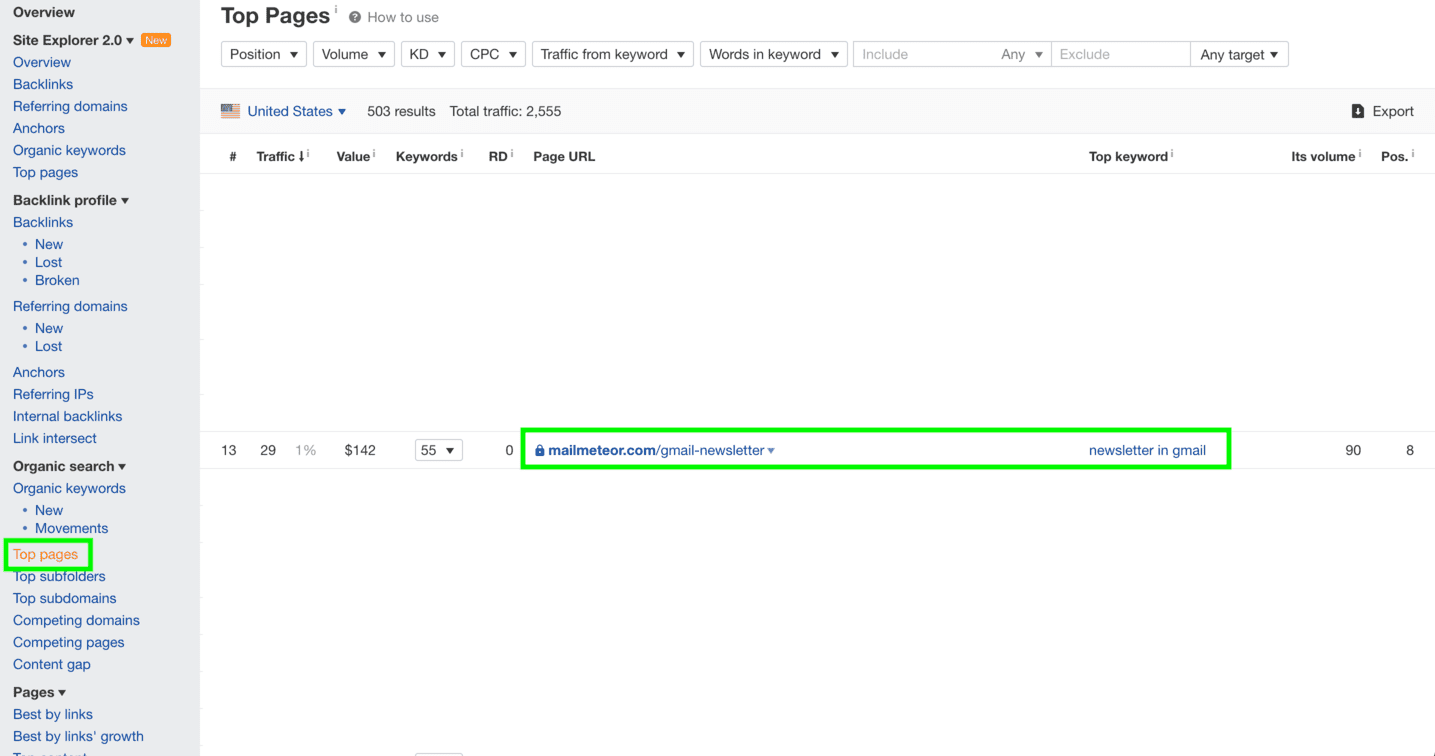
Then, we’ll search for the high-authority pages to add internal links from. An easy way to spot them is to run a Google search using the “site:” operator. In our example, I noticed there might be an opportunity for our Gmail newsletter landing page to be referenced from our complete mail merge in Gmail guide.

Alternatively, you can look at your website in the Site Explorer and check your website in the “Best by links” report.
A best practice is to do this every time you publish a new post on your blog.
Tip #7 - Fix your broken backlinks
This will lists all links pointing at 404 pages of your website. These pages don’t pass any link juice. A good solution in that case is to 301 redirect these pages.
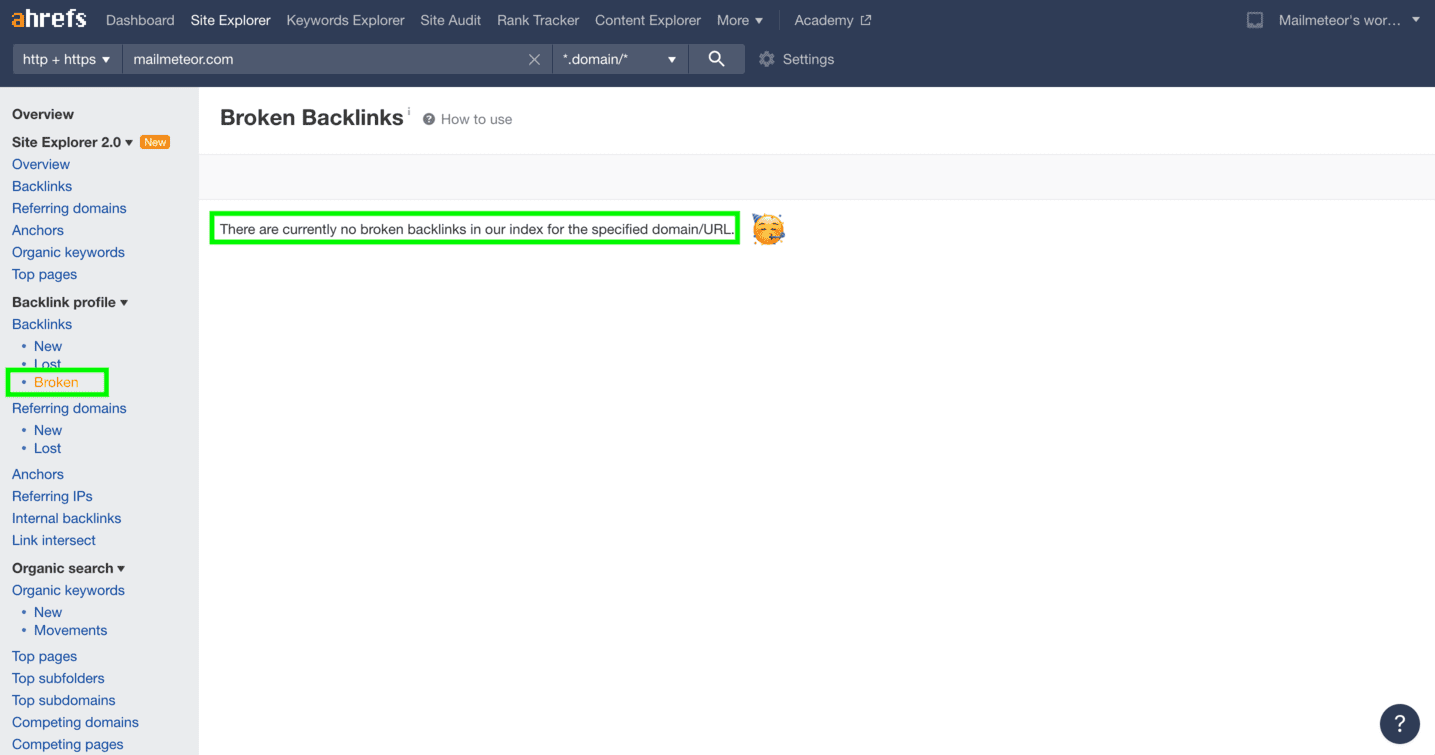
Tip #8 - Figure out why you are being outranked
Despite all your efforts you’re still behind in the search results? To fix that make sure you’re matching search intent first.
Check the top results for the topic you want to rank for and make sure your content is aligned to these results using the three C’s of searcher intent:
- Content type (blog, product page, category page, landing page)
- Content format (how-to, step-by-step, list, opinion pieces, reviews, comparisons)
- Content angle (unique selling point of the top-ranking posts)
Ask yourself: does my content fit these three C?

As an example, the 10 top results for “how to make pizzas” are all blog posts sharing step-by-step recipes explaining how to make pizzas at home. That’s probably what you should aim at if you want to increase your chances to get rank on this highly competitive topic.
Your content actually matches the search intent but keeps falling behind your competitors’?
Here is what you can check:
- Number of referring domains (RD column). If you have less referring domains than your competitors, try building more quality backlinks to your site. There are many ways you can achieve this. For example, you replicate your competitors’ links, do guest posting or pursue unlinked brand mentions.
- Page authority (UR column). If your UR is low, try building more page-level backlinks. Add strong and relevant internal links to your page
- Website authority (DR column). Need to gain authority? Keep up your SEO efforts as a whole and it will pay off in the long run!
SEO Competitors analysis
Tip #9 - Find your SEO competitors
Competing domains are websites that rank in the top 10 search results for the same keywords as yours.
The intersection graph helps visualize which competitors are really close to you and how much further you have to go. It’s interesting to check the keywords unique to your competitor and apply the recipe to find low competition keywords that you can steal from your competitors.

Tip #10 - Compare your domain with your competitors’
This recipe offers a comparison between competing domains. It’s a great way to compare your progress with your competitors. In case you notice you can’t keep up the pace, it can be the opportunity to reevaluate your strategy then derive new SEO tactics to beat your competitors.
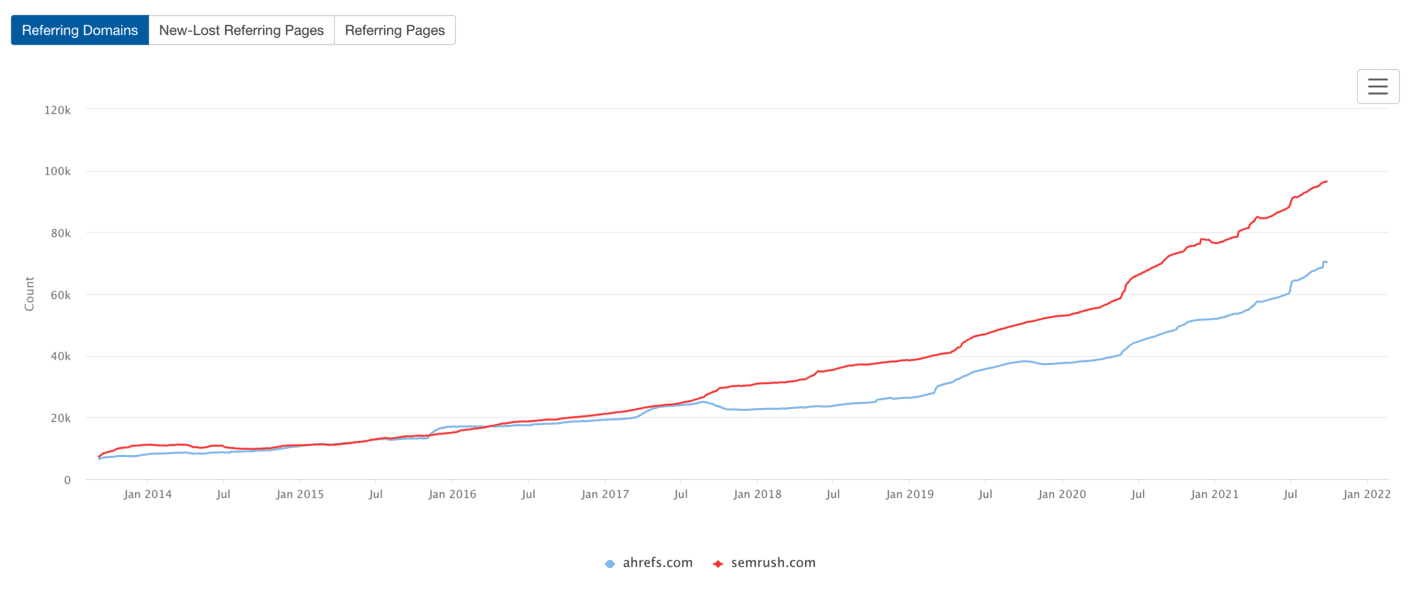
Tip #11 - Reveal your competitors’ most popular pages
Using this recipe you’ll be able to reveal your competitor’s top-performing pages. Quickwin: look at the pages you could easily outperform by isolating the ones generating a lot of traffic but with little or no referring domains (play with the volume and RD filters). When you find an interesting page, go further by clicking on the associated “Keywords” dropdown to unveil the keywords that page ranks for in the top 100 search results.
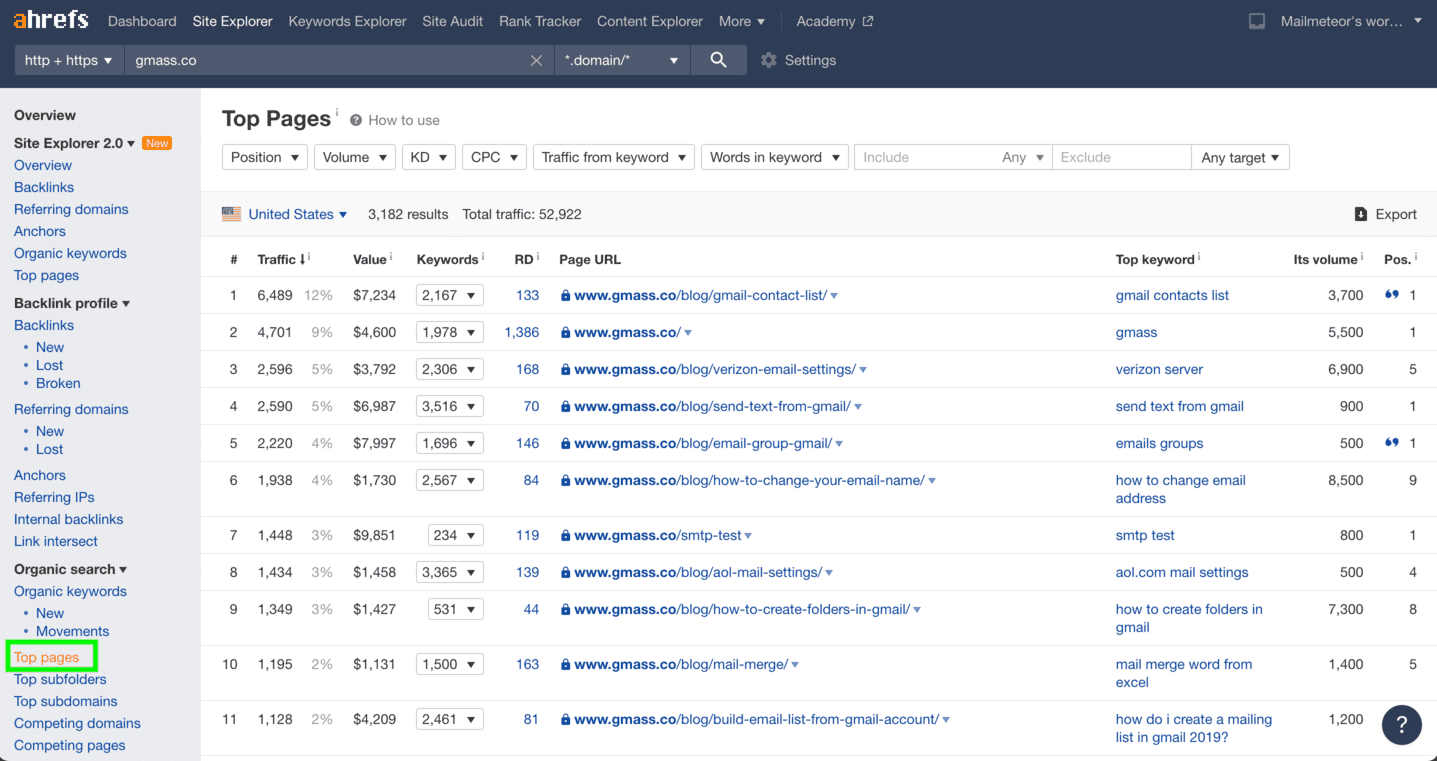
Tip #12 - Identify gaps in your content strategy
This report contains a treasure trove of keywords your website doesn’t rank for while your competitors are already positioned on them. Note that it’s also possible to apply this recipe to a specific URL of your website if you want to check which keywords might be missing from your page compared to the top rankings.

Tip #13 - Spy on your competitors’ paid advertising strategy
This recipe will unveil your competitors paid ads strategies. Knowing where your competitors spend most of their money on ads is powerful. This can help you refine your SEO strategy by highlighting keywords with a lot of commercial intent. Also, it can help you avoid overly competitive keywords if you’re just starting out.
Take some time to study the landing page associated with your competitors’ ads. In our example, we can notice that Sendinblue is using a landing subdomain for its ads related content. Studying their most successful pages structure would be a source of inspiration the day we decide to burn some money in advertising too.
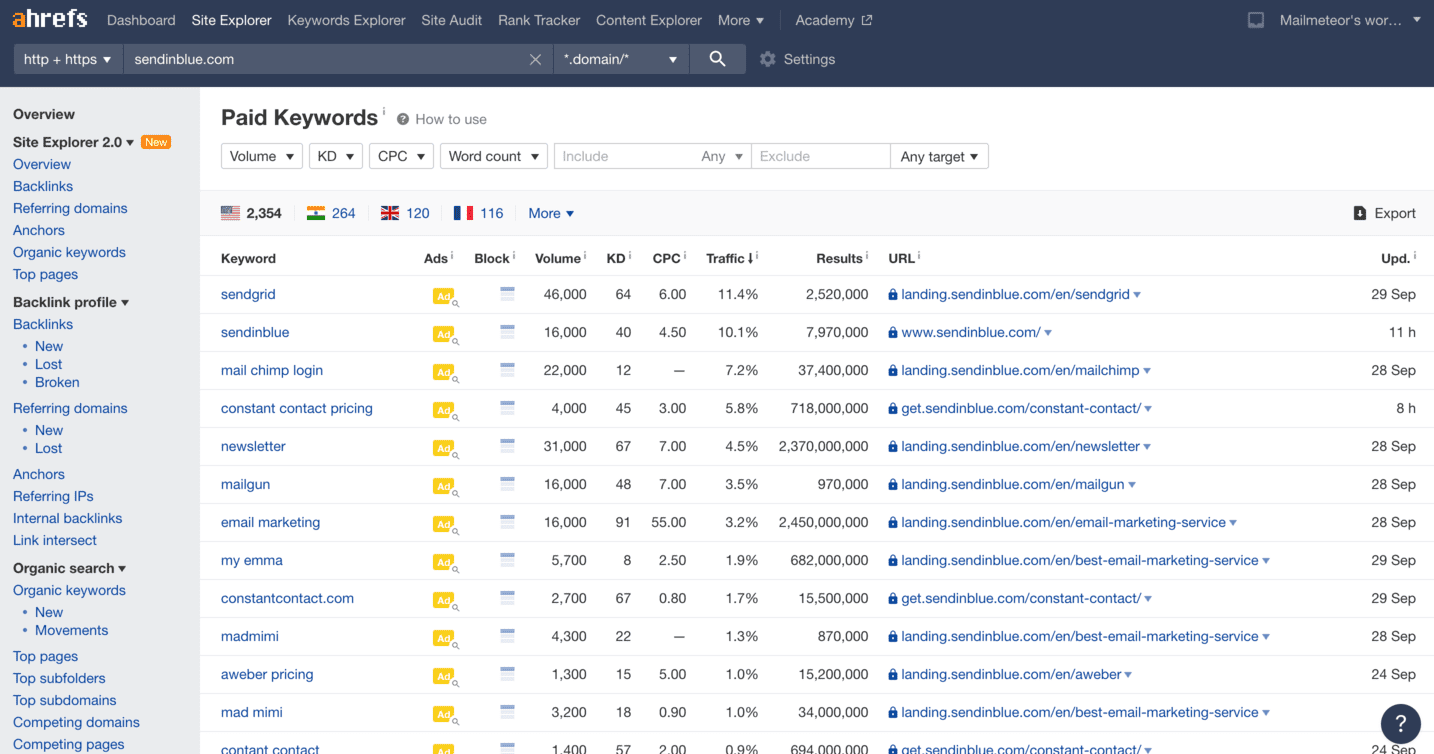
Tip #14 - Check your competitors’ content clusters
It’s useful to understand how your competitors structured their website content. This recipe will help you see at a glance which sections of your competitors’ websites are generating the most traffic. In our example, we can see that Mailchimp had great success building a marketing glossary pillar page with 49 children definition pages.
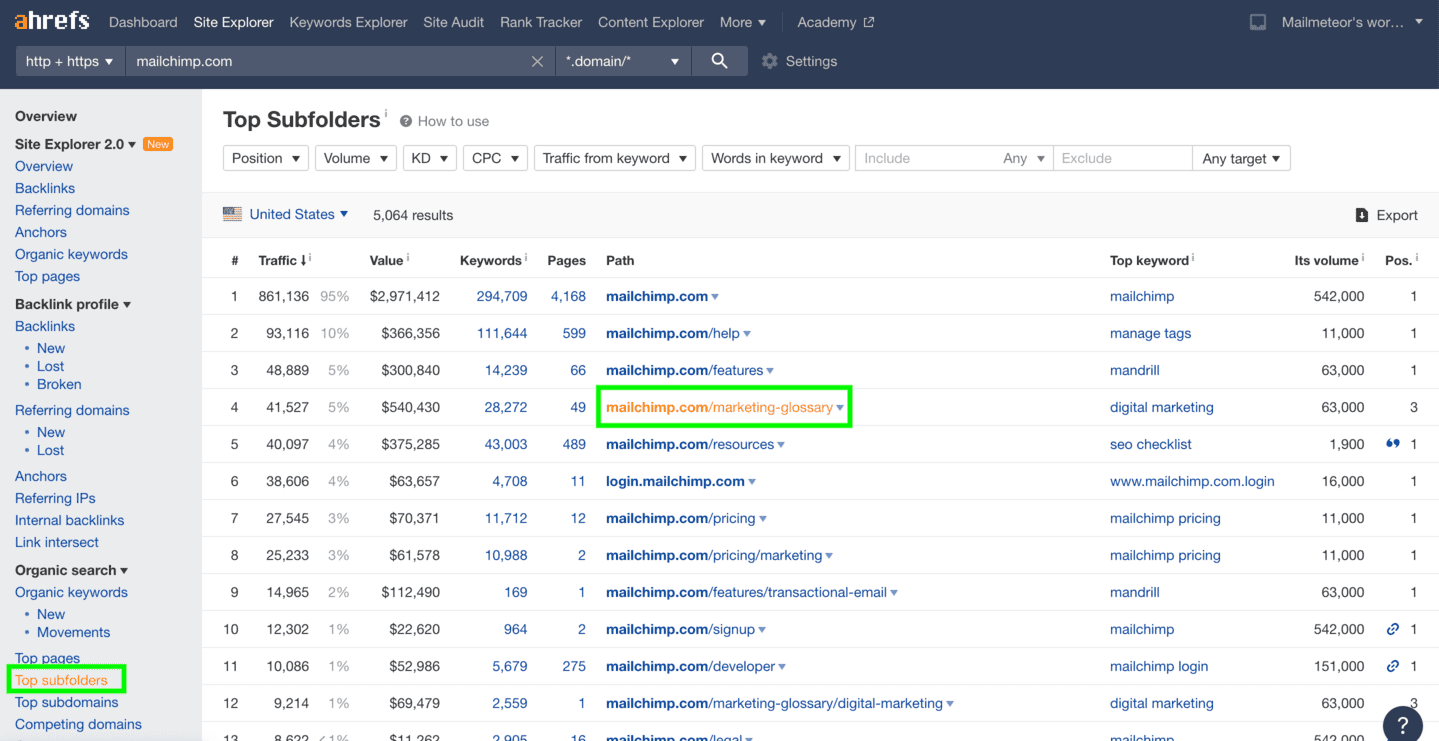
Tip #15 - How to find questions your competitors are answering that you aren’t
A quick recipe to identify top or mid funnel questions your competitors are answering, but you aren’t. That way you can catch up and fill in the holes in your content.
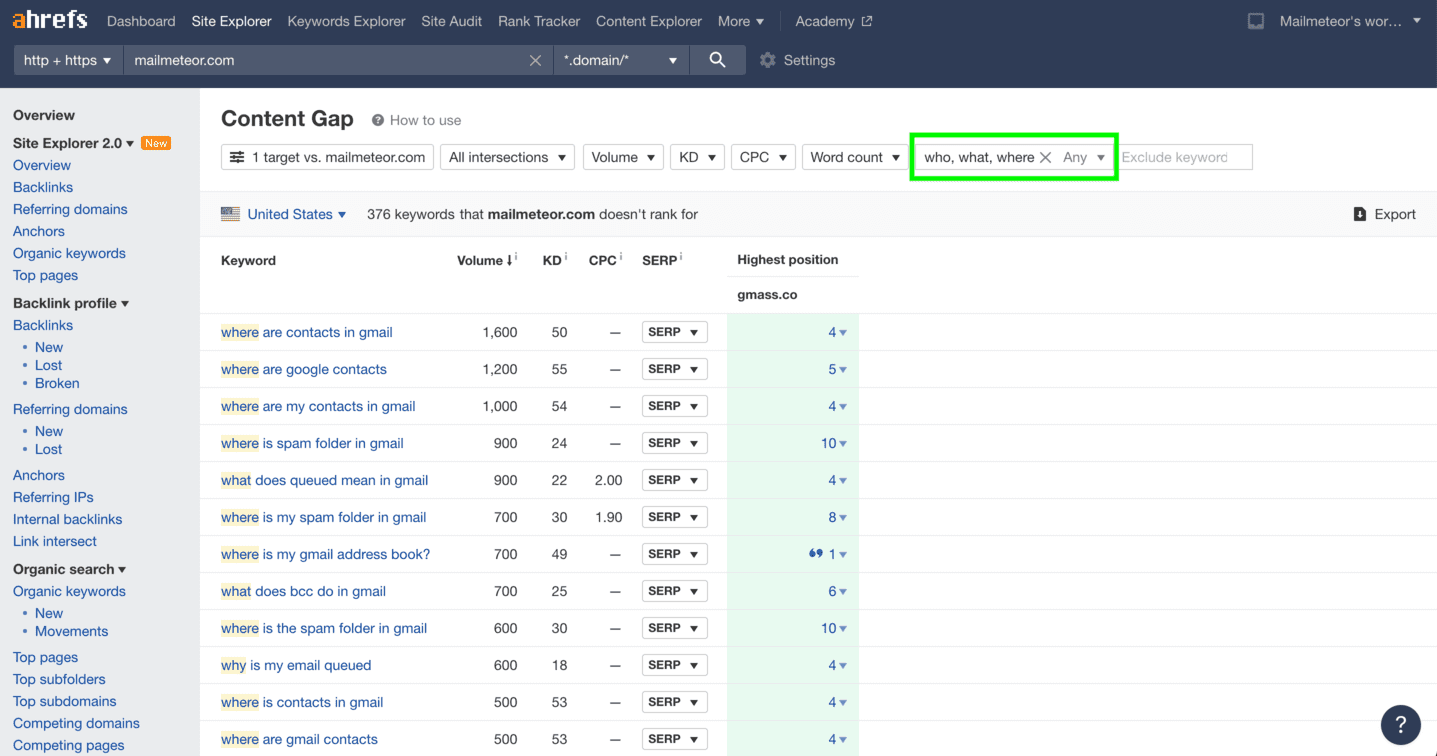
Tip #16 - Check competitors’ content velocity
This method helps you check how many pages your competitors have published in the last month. You can analyze their content velocity in different time periods. Of course, don’t focus too much on what your competitors are doing. Study winners in other industries!
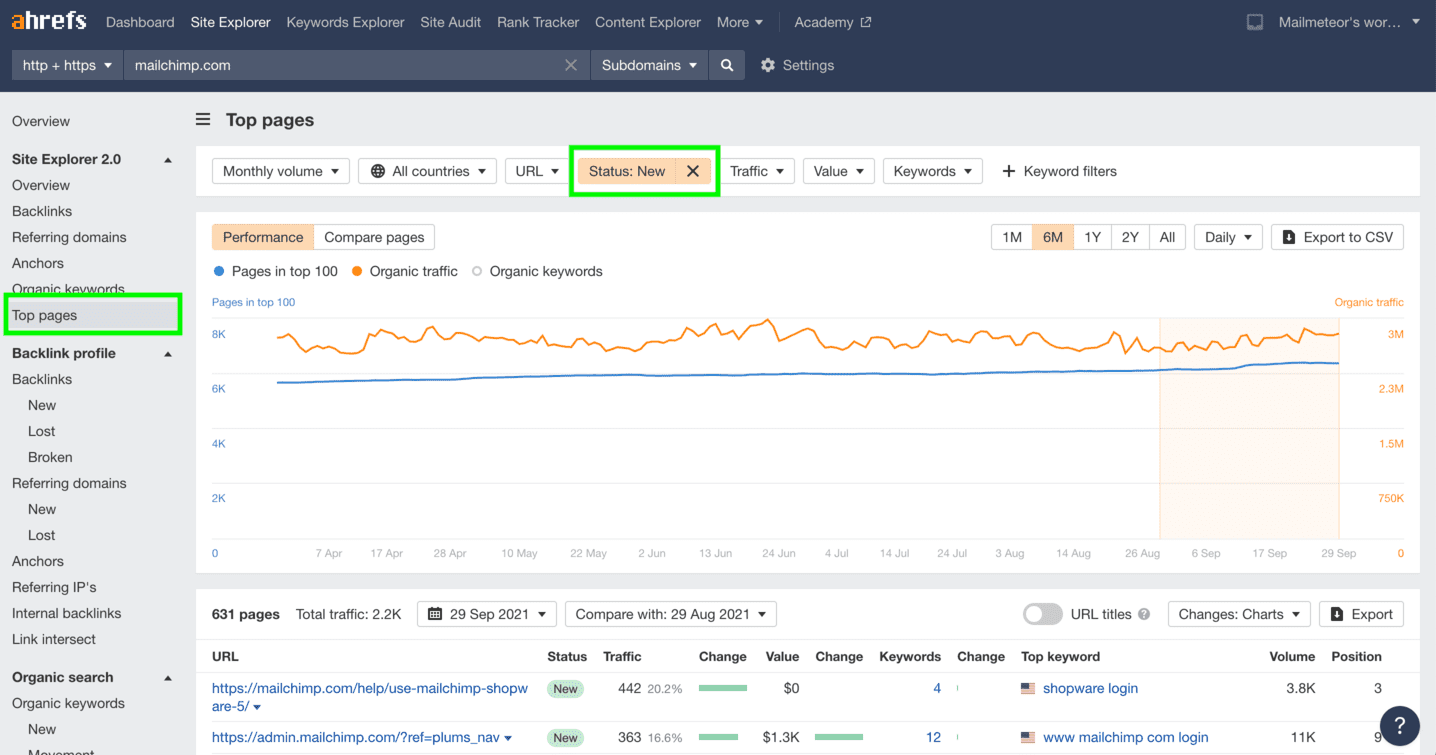
Tip #17 - Understand how your competitors are acquiring backlinks
It’s insightful to better understand how your competitors acquired their backlinks. Indeed, it can be a source of inspiration for your own backlink building.
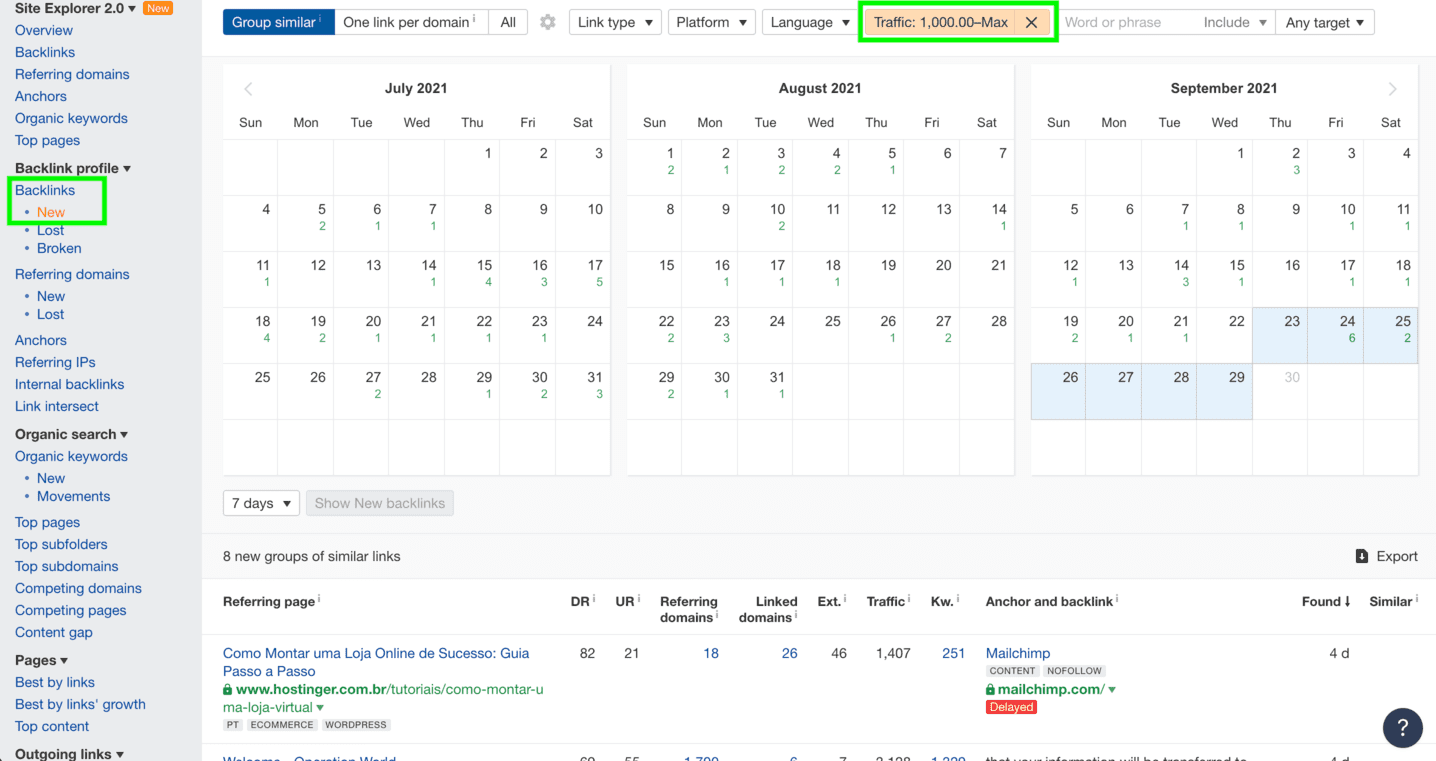
Tip #18 - Find your competitors’ broken or redirected pages with a lot of backlinks
With that combination, you’ll have a complete list of all the broken pages on your competitor’s site. By using the “best by links” report, we get the broken pages with a lot of backlinks.
It could be interesting for you to recreate content, then reach out to the websites linking to your competitors’ broken pages. Offer them to replace the dead links with your new content. Alternatively, use this recipe to find 301 redirect pages on your competitors’ websites and apply the same tactic.
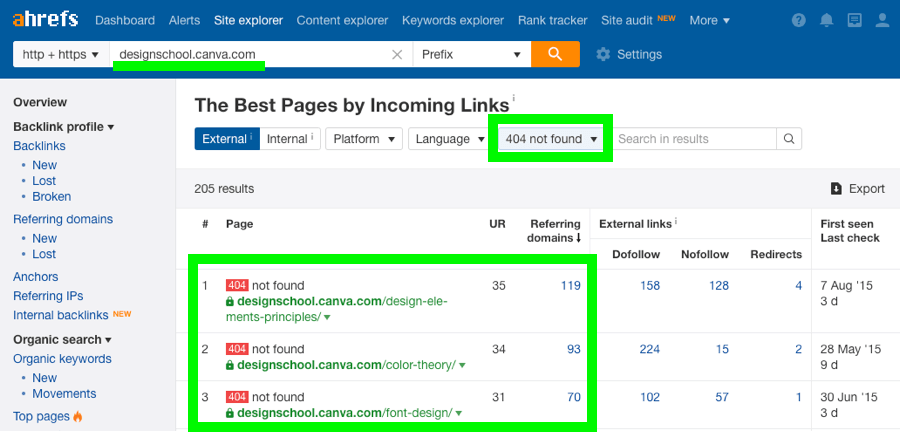
Link building
Tip #19 - Identify guest blogging opportunities
This recipe will help you find websites relevant to your topic that have yet to link to you. As a next step, you could reach out to the authors to see if they would be interested in a guest post.
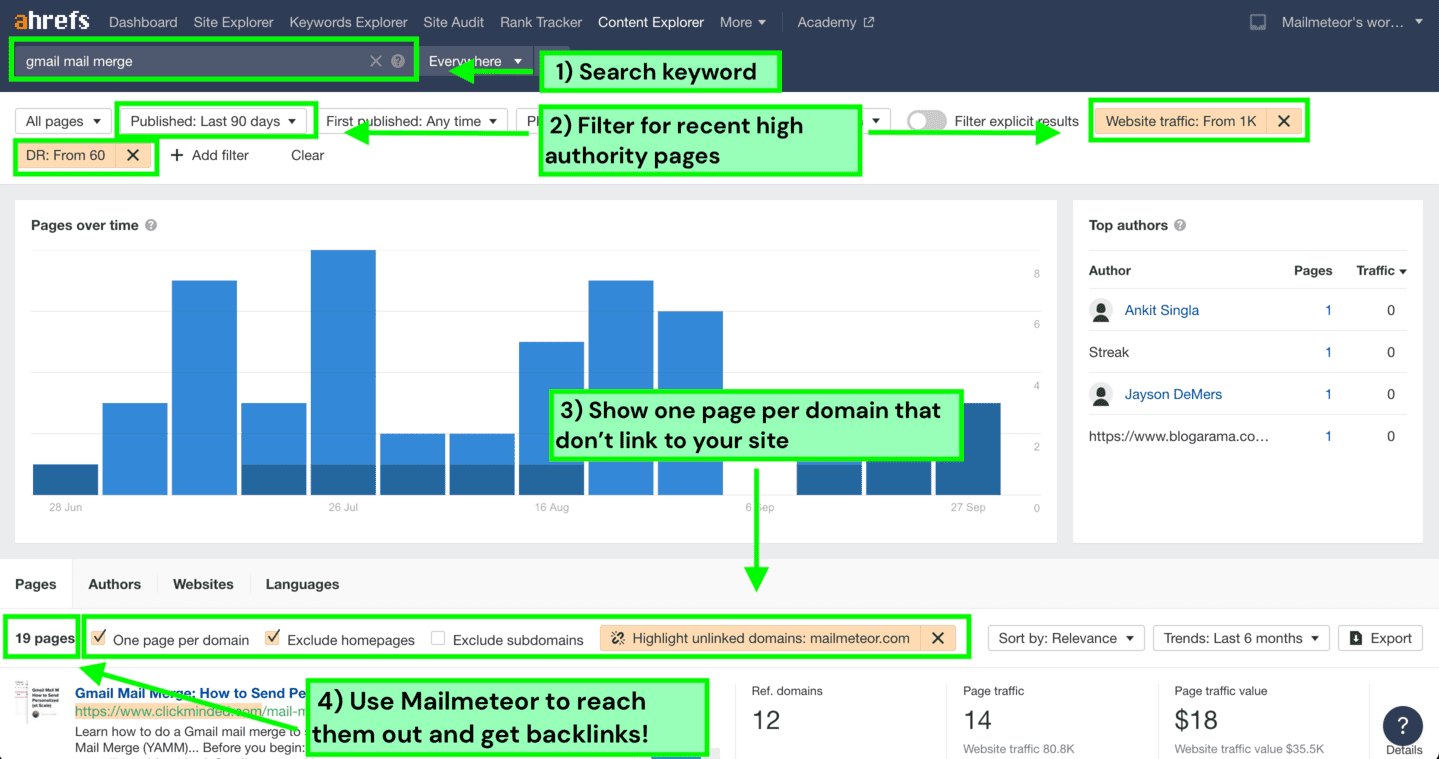
I filtered articles with “one article per domain” to ensure only 1 article is shown per domain. Highlighting unlinked mentions is useful to isolate websites that don’t have a backlink to yours. Like usual, you can go further by filtering results based on the published date or using the domain rating as a proxy (you want backlinks from high authority websites).
Bonus tip: How to crush SEO email outreach using Mailmeteor
Instead of emailing bloggers about their old pieces of content (that are probably long forgotten), try reaching out about their most recent articles! It’s easy to find plenty of fresh outreach prospects for any topic using the Content Explorer.
There are 3 simple steps to running a successful SEO outreach campaign:
- Find recent link-worthy articles using the recipe above
- Publish an even better content
- Reach out to the right people with the most personalised emails you can
Mailmeteor can help you with that. Once you have collected the email addresses of interesting people, draft a personalised email template. Here is an example:
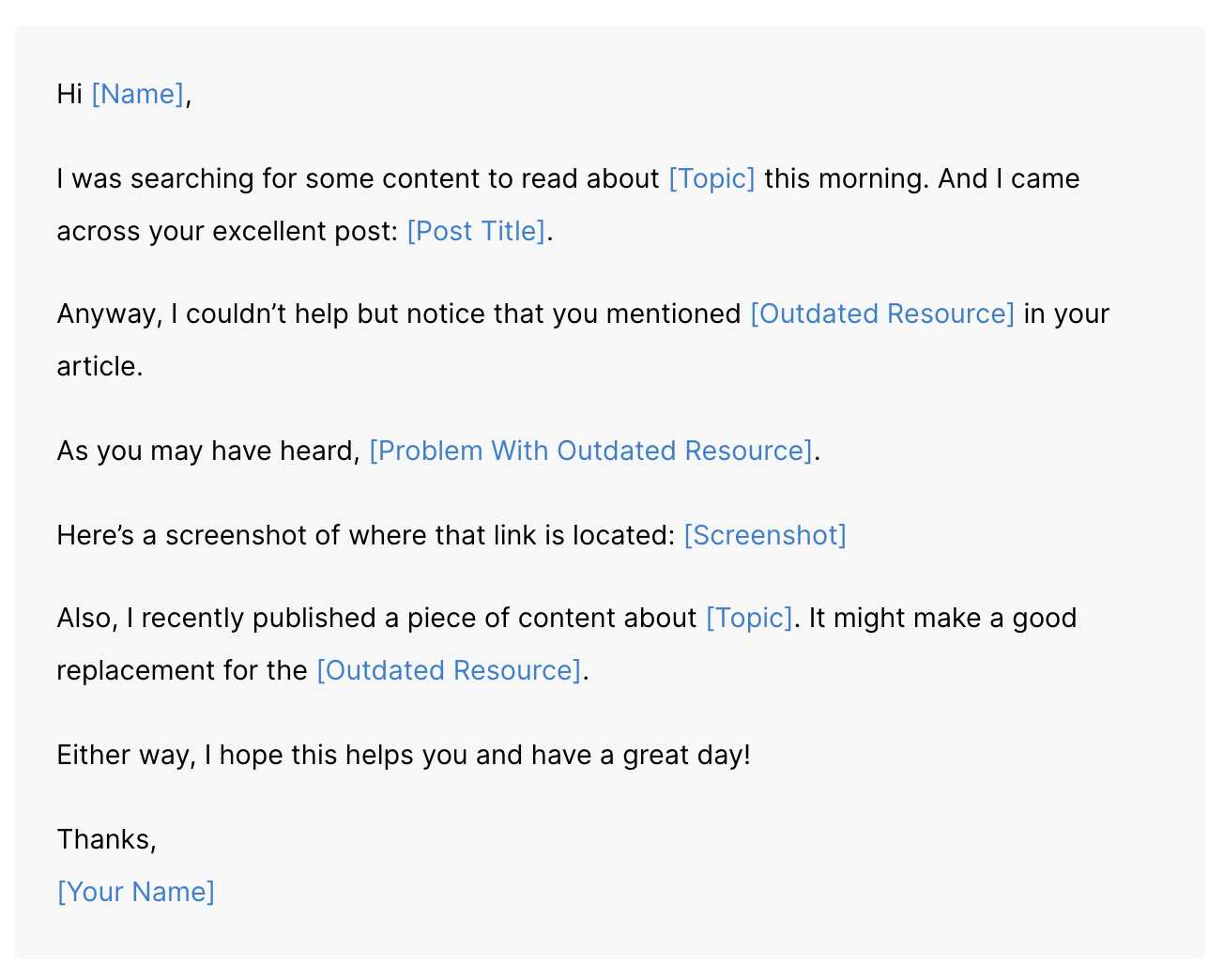
Make sure it is highly personalised to your target audience. Then use Mailmeteor to send personalised mass emails with Gmail. Here is a quick demo:
Tip #20 - Find if a specific website has linked to yours
A convenient method if you need to check that a website has already been linked to you.
That’s a valuable piece of information you would like to have in case you are using email outreach for SEO link building.
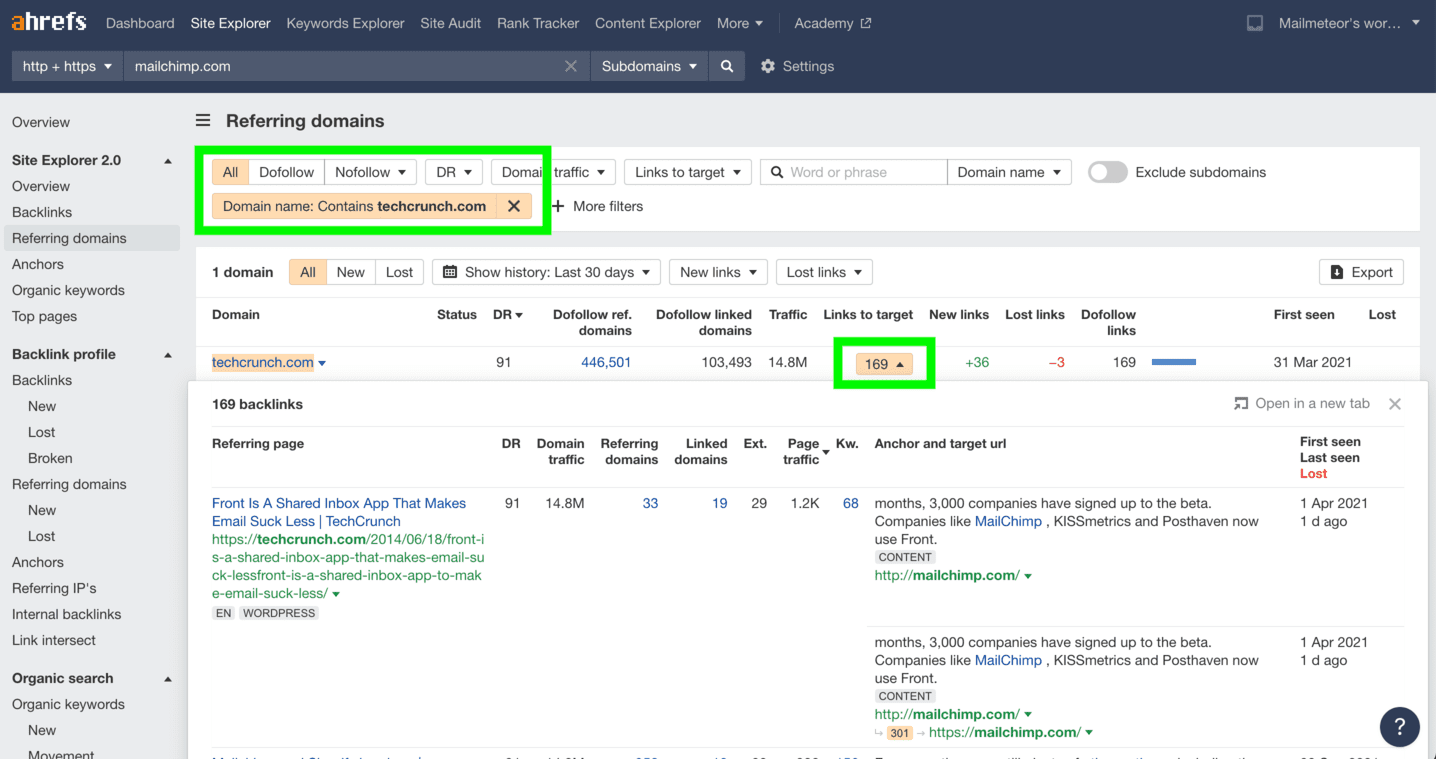
Tip #21 - Find Quora questions to answer that are related to your niche
This recipe will give you a list of relevant Quora questions that receive the most search traffic. It’s a good place to start when building your brand awareness.
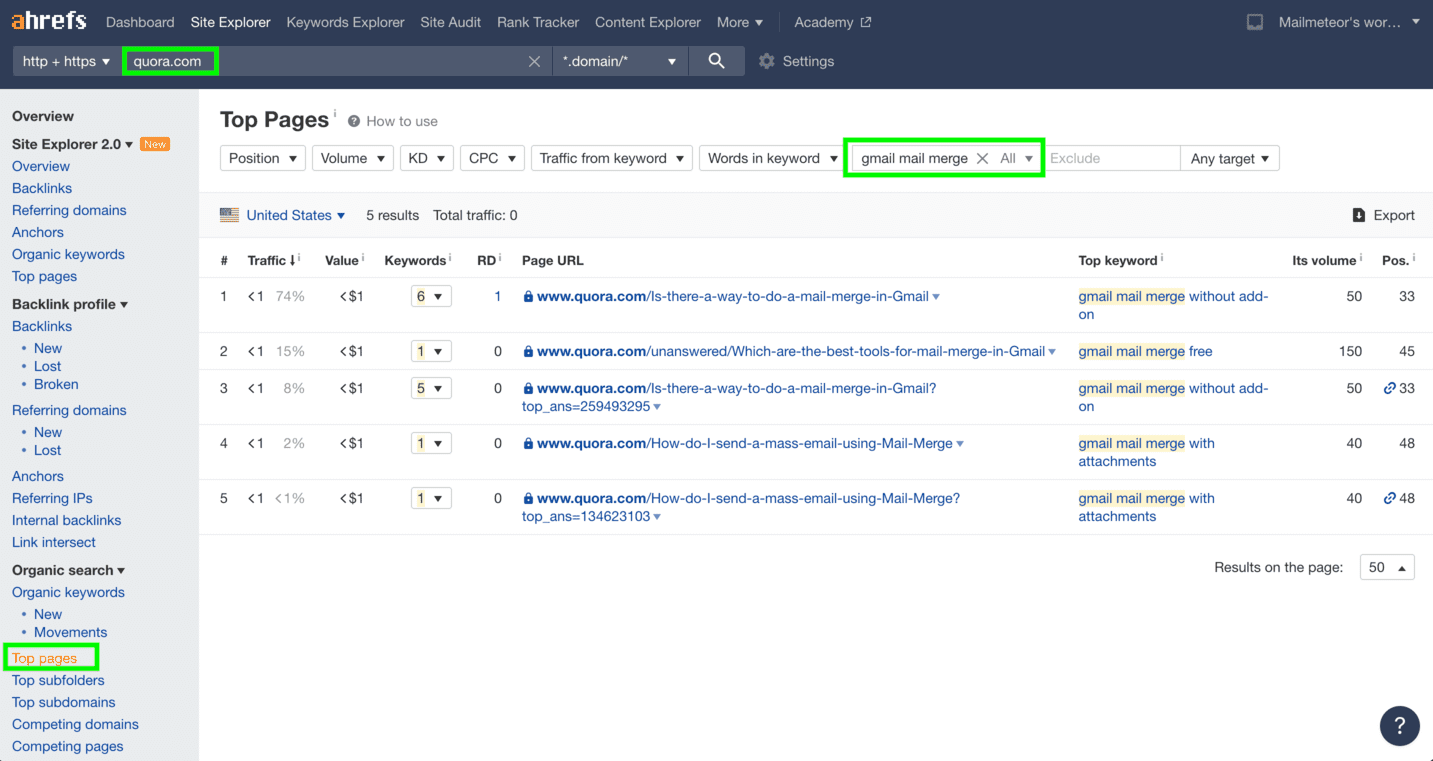
Going further
Tip #22 - Monitor your brand mentions over time
This recipe will show your brand mentions over time, from all sites except yours. An easy way to monitor your brand mentions without a costly PR measurement tool.
In addition, you could set up an Alert in Ahrefs to spot new brand mentions. It would help you find unlinked brand mentions that you can claim: when checking the new brand mentions, verify that the websites are well linked to you. If not, try reaching them out to request a backlink.
This recipe can also apply to monitor your competitors’ brand mentions.
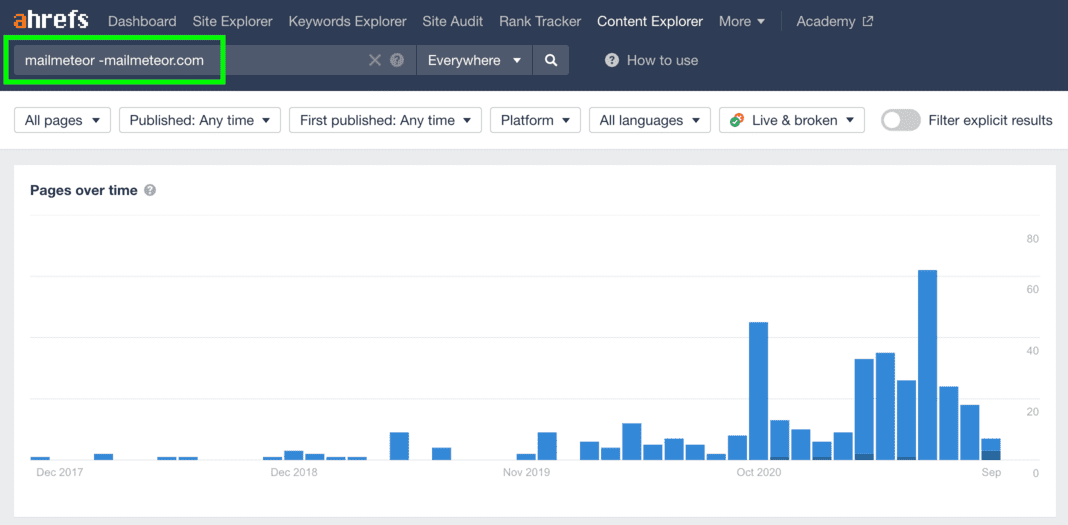
Tip #23 - Browse the entire Ahrefs keywords database
Did you know that you can access the entire Ahrefs database by running an empty search (that’s roughly 4 billions keywords in total).
Wander through the top searches in the country of your choice, France for example. You can then improvise yourself as a modern anthropologist and reveal what Google searches tell about who we are.
More seriously, it’s also a great way for affiliate SEOs who are struggling to discover new cool niches. By playing with the filters you can discover some keywords/niches that you wouldn’t otherwise think of.
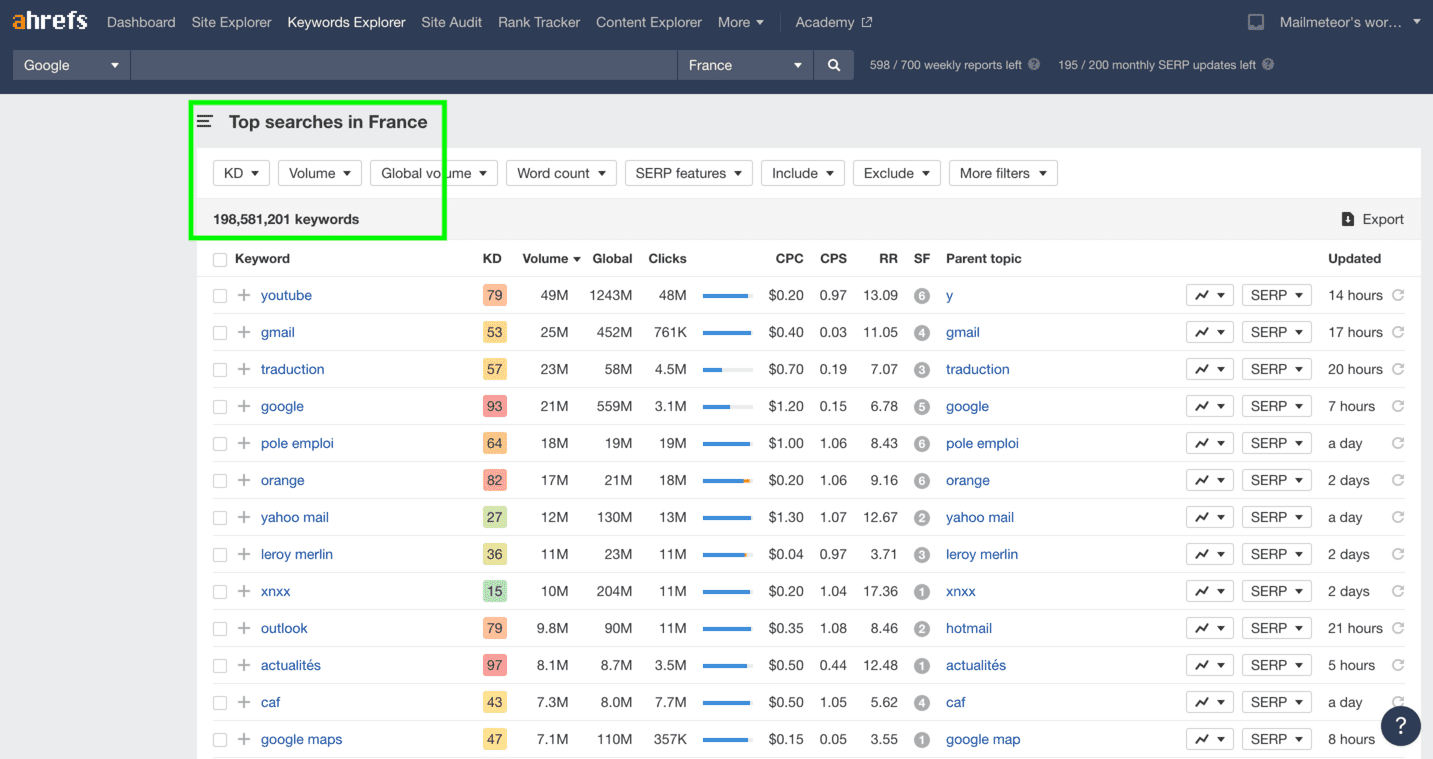
Tip #24 - Measure search seasonality
You have two volume options here, a monthly and average one. The monthly graph shows if there’s any seasonality to the domain’s search traffic, or if the popularity of keywords it ranks for is growing. The average volume will be more about general SEO visibility. As you can see in my example, our competitor got an impressive surge of organic traffic in January 2019. It will definitely be interesting to dig further to see if there’s something we could learn from them.

Tip #25 - Local SEO: the “near me” trick
Discover millions of keywords related to local businesses & services with this simple search. Play with the different filters to narrow down interesting topics in your niche.
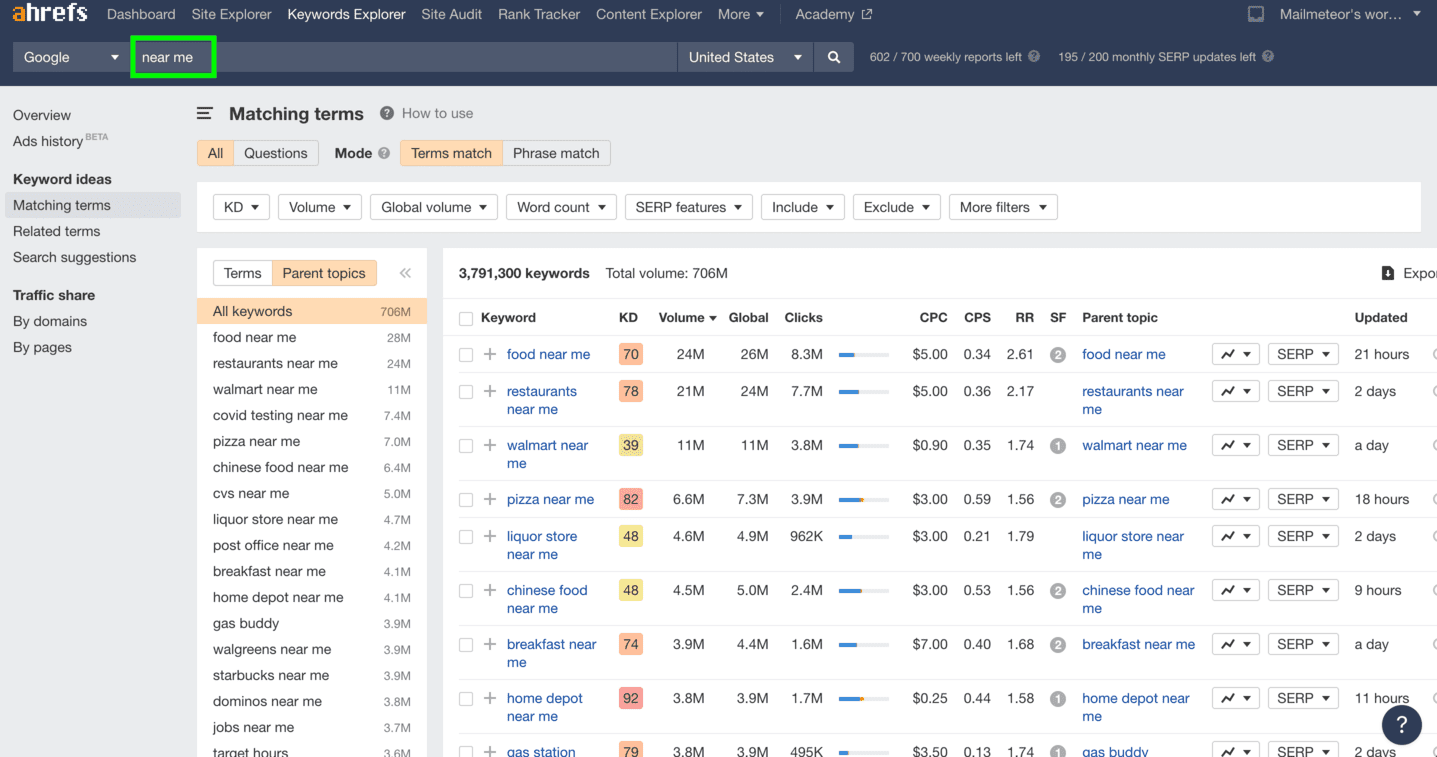
Final thoughts
Voilà! You know the secret sauce to become a SEO expert chef. Of course, there are many other things you could do with SEO tools like Ahrefs.
I’d be glad to hear about your best recipes, get in touch with me on Twitter to share the tips I might have missed.
Thanks to @timsoulo and @samsgoh and all the anonymous that shared their best SEO tips presented here over the years.
And… if you truly want to scale your backlinks efforts, give a try to Mailmeteor!



